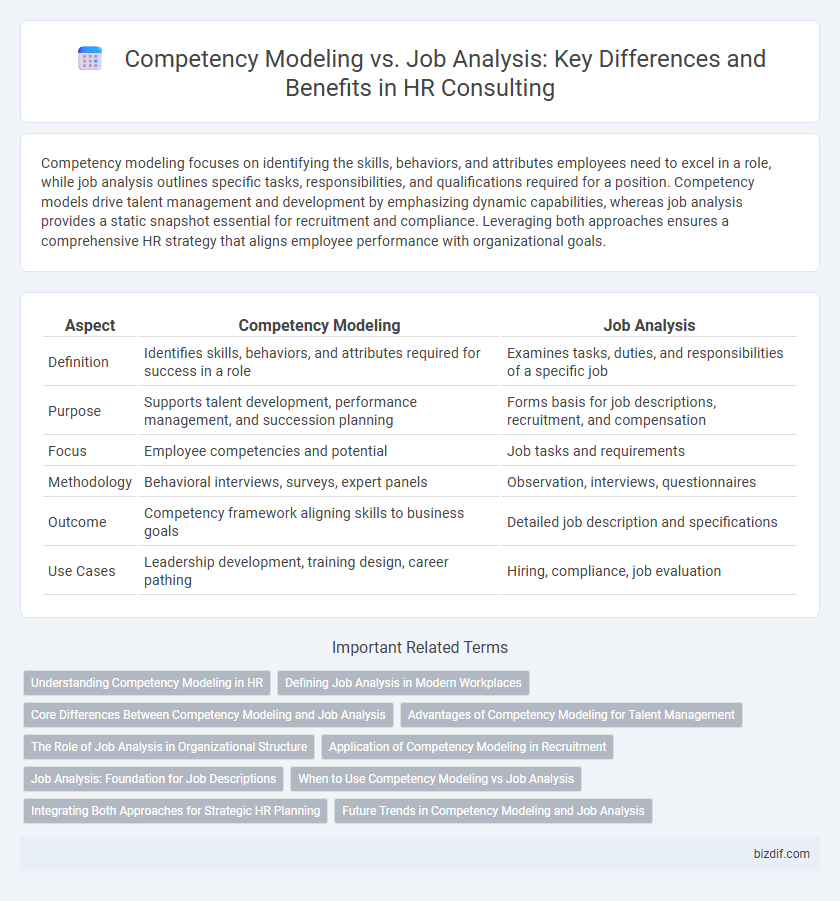Competency modeling focuses on identifying the skills, behaviors, and attributes employees need to excel in a role, while job analysis outlines specific tasks, responsibilities, and qualifications required for a position. Competency models drive talent management and development by emphasizing dynamic capabilities, whereas job analysis provides a static snapshot essential for recruitment and compliance. Leveraging both approaches ensures a comprehensive HR strategy that aligns employee performance with organizational goals.
Table of Comparison
| Aspect | Competency Modeling | Job Analysis |
|---|---|---|
| Definition | Identifies skills, behaviors, and attributes required for success in a role | Examines tasks, duties, and responsibilities of a specific job |
| Purpose | Supports talent development, performance management, and succession planning | Forms basis for job descriptions, recruitment, and compensation |
| Focus | Employee competencies and potential | Job tasks and requirements |
| Methodology | Behavioral interviews, surveys, expert panels | Observation, interviews, questionnaires |
| Outcome | Competency framework aligning skills to business goals | Detailed job description and specifications |
| Use Cases | Leadership development, training design, career pathing | Hiring, compliance, job evaluation |
Understanding Competency Modeling in HR
Competency modeling in HR focuses on identifying and defining the specific skills, behaviors, and attributes required for effective performance in a given role, aligning talent development with organizational goals. It goes beyond traditional job analysis by emphasizing future-oriented capabilities and cultural fit, creating a framework for recruitment, training, and performance management. This approach enhances workforce agility and drives strategic talent management by linking competencies directly to business outcomes.
Defining Job Analysis in Modern Workplaces
Job analysis in modern workplaces involves systematically identifying the tasks, responsibilities, skills, and outcomes required for a specific role to ensure alignment with organizational goals and workforce capabilities. This process uses data collection methods such as interviews, observations, and surveys to create accurate job descriptions and performance criteria. By providing a foundation for recruitment, training, and performance management, job analysis supports effective talent management and regulatory compliance in dynamic business environments.
Core Differences Between Competency Modeling and Job Analysis
Competency modeling emphasizes identifying the skills, behaviors, and attributes employees need to perform successfully in a role, targeting future performance and development potential. Job analysis focuses on defining specific tasks, duties, and responsibilities tied to a job, providing detailed descriptions for recruitment, compensation, and compliance. Competency models align with strategic workforce planning, while job analyses ensure accuracy in job documentation and regulatory adherence.
Advantages of Competency Modeling for Talent Management
Competency modeling enhances talent management by providing a clear framework that aligns employee skills with organizational goals, improving recruitment and development processes. It enables targeted training programs and succession planning by identifying critical behaviors and capabilities required for success. This approach fosters better performance management and employee engagement through a consistent and measurable set of competencies.
The Role of Job Analysis in Organizational Structure
Job analysis serves as a foundational tool in defining organizational structure by systematically identifying job roles, responsibilities, and required skills, ensuring alignment with strategic goals. It provides detailed data essential for competency modeling, which builds on this information to develop targeted performance standards and employee development frameworks. Effective job analysis enhances organizational design by clarifying role expectations and optimizing workforce deployment.
Application of Competency Modeling in Recruitment
Competency modeling streamlines recruitment by clearly defining the skills, behaviors, and attributes necessary for optimal job performance, enabling targeted candidate assessment and selection. Unlike traditional job analysis that focuses on tasks and duties, competency models emphasize future-oriented capabilities aligned with organizational goals, enhancing talent alignment and retention. Leveraging competency frameworks in recruitment tools improves the precision of matching candidates to company culture and role requirements, ultimately boosting workforce effectiveness.
Job Analysis: Foundation for Job Descriptions
Job analysis provides a systematic process for collecting detailed information about job responsibilities, tasks, skills, and work environment, forming the essential foundation for accurate job descriptions. It ensures that job descriptions align with organizational goals and labor market standards by capturing core duties and performance expectations. Accurate job descriptions derived from thorough job analysis improve recruitment efficiency, employee performance assessments, and compliance with labor regulations.
When to Use Competency Modeling vs Job Analysis
Competency modeling is ideal for strategic talent management, leadership development, and aligning employee skills with organizational goals. Job analysis is best suited for accurate job descriptions, regulatory compliance, and establishing specific task requirements. Use competency modeling when focusing on future performance and capabilities, while job analysis is preferred for current job roles and objective task details.
Integrating Both Approaches for Strategic HR Planning
Integrating competency modeling with job analysis enhances strategic HR planning by combining detailed task-based job descriptions with the broader behavioral competencies needed for future organizational success. Competency models provide a framework for employee development, leadership grooming, and succession planning, while job analysis ensures accurate role clarity and compliance with regulatory standards. Together, these approaches enable HR professionals to design talent management systems that align workforce capabilities with evolving business objectives.
Future Trends in Competency Modeling and Job Analysis
Emerging trends in competency modeling emphasize integrating artificial intelligence and data analytics to predict future skill requirements, enabling organizations to proactively develop talent aligned with evolving business needs. Job analysis is increasingly incorporating real-time data and continuous feedback mechanisms to capture dynamic job roles and adapt to rapid technological changes. The convergence of these approaches supports agile workforce planning and enhances strategic HR decision-making through precise identification of competencies and job functions critical for future organizational success.
Competency Modeling vs Job Analysis Infographic

 bizdif.com
bizdif.com